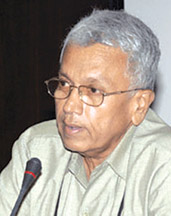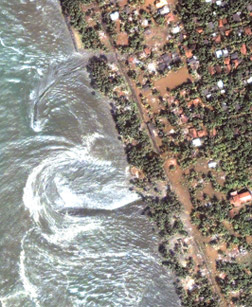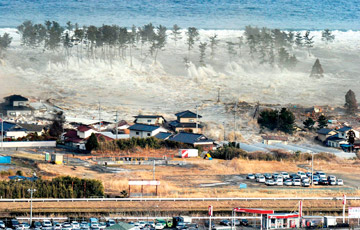Japan’s earthquake has no impact on Sri Lanka - Senior Geologist
by Manjula Fernando
|

Dr. Kapila Dahanayake
|
Dr. Kapila Dahanayake, retired Head of Peradeniya University’s
Geology Department speaking with his experience as a Senior Professor of
Geology for nearly two decades says Sri Lanka has nil or minimal impact
due to the massive earthquake that shattered the north eastern coast of
Japan, bringing about widespread destruction and death to thousands of
people.
 “It is very difficult to imagine that Sri Lanka would suffer any
major impact, since we are not on the same tectonic set up. The
likelihood is nil or minimal,” he said in an interview with the Sunday
Observer. “It is very difficult to imagine that Sri Lanka would suffer any
major impact, since we are not on the same tectonic set up. The
likelihood is nil or minimal,” he said in an interview with the Sunday
Observer.
Dr. Dahanayake said the US and Japanese seismologists and geological
experts had been researching for a technology to accurately read
fore-shocks and predict destructive earthquakes but so far there has not
been a satisfactory breakthrough.
This proves, despite making giant strides in the field of technology
and innovations, humans are lagging far behind when it comes to dealing
with Mother Nature, especially when she is in a state of fury.
The full interview:
Q: What triggered the destructive earthquake in Japan? Can there be
any adverse implications to Sri Lanka due to this geological occurrence,
especially since there has been heightened seismic activity in the
region in the recent past?
A: Japan is located bordering a very active tectonic plate
intersection. (About dozen cool rigid slabs called tectonic plates form
the outer most shell of the planet earth.) Eurasian, Philippine and
Pacific plates converge at this intersection. This area is known as the
‘Ring of Fire’ for its unpredictably intense seismic activity that
triggers earthquakes any time of the year.
These tectonic/Oceanic plates which are about 80 kilometres thick,
move 1 to 10 centimeters per year. As a result the boundaries grind with
each other building up stress and resulting eruptions along vents.
 This sudden release of pressure along ruptures creates an earthquake.
A powerful earthquake of more than 6.5 magnitude could cause a tsunami
if the movement of plates is vertical. This is what happened in Japan on
Friday, March 11. This sudden release of pressure along ruptures creates an earthquake.
A powerful earthquake of more than 6.5 magnitude could cause a tsunami
if the movement of plates is vertical. This is what happened in Japan on
Friday, March 11.
Although this particular earthquake, the US Geological Survey
recorded as 8.9 point on the Richter scale, was the 7th biggest the
world has ever recorded and the single largest in the recorded history
of Japan, it is highly unlikely that Sri Lanka could be in danger of any
adverse implications.
If there was any impact, there has to be indications within the
country as soon the earthquake hits. For instance soon after the 2004
Boxing day earthquake at 7.00am near Sumatra Islands, which triggered
the highly destructive tsunami, there were landslides without rain, a
house completely collapsed in Walapane and there were reports of unusual
water springs (oozing of water) in Naula area in the Matale district.
Sri Lanka is located on Indo-Australian tectonic plate, different
from Eurasian plate where Japan is located. The fault lines are not
intimately related, thus I don’t think Sri Lankans should feel
uncomfortable following the Japan’s disaster. It is very difficult to
imagine having any major impact since we are not on the same tectonic
set up. The likelihood is nil or minimal.
Q: Japan is the most technologically advanced nation in the world.
Japanese have lived with such natural calamities all their lives.
Earthquake awareness for them begins elementary school. Why couldn’t the
massive destruction and loss of lives be avoided? Isn’t there a proven
mechanism to predict earthquakes?
A: At the moment there is no technology that can accurately predict
an earthquake. In the future it maybe possible. The key is the tremors
that forerun a major earthquake (fore-shocks). These signals have to be
properly interpreted. Tsunamigenic earthquakes too cannot be accurately
predicted at the moment.
Seismic experts believe the two recent powerful earthquakes in Chile
(8.8 point) last year and New Zealand (7.2) in February could be related
to Japan’s Sendai quake. Scientists believe that earthquakes occur in
clusters.
Q: Any research being conducted in this direction?
A: US Geological Survey and Japanese seismic experts have been
conducting studies to evolve a reliable technology to accurately predict
destructive earthquakes. But so far their research has not been
successful.
Q: The unimaginable destruction and the loss of life following the
quake made a mockery of the fact that the Japanese are the most prepared
when it comes to natural calamities like earthquakes and tsunamis?
A: Of course Japan was vulnerable and they had the most advanced
early warning systems in the world. But the only option in a tsunami is
to reach higher ground as soon as possible. Sendai was an extensive
coastal plain. In the affected area there was no highland except in
buildings.
Many of the buildings may not have been able to withstand the sheer
force of the 8.9 magnitude earthquake. And then the giant tsunami
struck. According to the Japan Meteorological Agency the waves as high
as 7.3 metres (22 feet) reached the country’s eastern coast.
No amount of preparedness would have saved the people from such a
forceful tsunami.
The following is the NASA and USGS data on the March 11 quake near
Sendai:
On March 11, 2011, at 05:46 Universal Time, a magnitude 8.9
earthquake struck off the east coast of Japan. (by today USGS has
updated the magnitude of the quake to 9.0) The epicenter was 130
kilometers (80 miles) east of Sendai, and 373 kilometers (231 miles)
northeast of Tokyo. If initial measurements are confirmed, it will be
the world’s fifth largest earthquake since 1900 and the worst in Japan’s
history.
The earthquake occurred at a depth of 24.4 kilometers (15.2 miles)
beneath the seafloor. The March 11 earthquake was preceded by a series
of large foreshocks on March 9, including an magnitude 7.2 event.
Q: In 2003 a massive earthquake measuring 8.3 point on the Richter
scale rocked the island of Hokkaido. But there were no casualties as
against the massive destruction caused by March 11 quake?
(According to USGS only 589 people were injured following Hokkaido
earthquake. The epicentre was 140 kilometres off south west of Hokkaido
and occurred at a depth of 27 km from the sea bed. A tsunami wave of 4
metre height was generated in some places.)
A: Hokkaido is a sparsely populated island and a mountainous area
compared to Sendai. The physical damage is also determined by the speed
with which the tsunami waves travel.
A tsunami wave can have a speed from 500 km to 1000km per hour. Also
if the tectonic plate movements were angular, not 90 degrees vertical
the waves can be less destructive. It means that the strength of the
earthquake is not the sole factor determining the extent of damage
following a disaster like that.
Q: What will happen if a similar earthquake and tsunami hit Sri
Lanka?
A: I think there will be more survivors. Sri Lanka’s coastal plain is
not as wide as Japan’s and the people in the coastal belt in most of the
places can reach highland within short notice in the event of a tsunami.
But the people in the eastern coastal stretch of Sri Lanka will be more
vulnerable than those in the Southern and Western coasts.
The tsunami warning system established after the 2004 disaster is
very reliable and we maintain close links with international centres in
the Pacific region.
But there has been tsunami waves about 10 metres in height and over
in history. If that is the case there will be little hope.
Q: Could the freak weather patterns experienced worldwide due to La
Nina and El Nino conditions have any impact on seismic activity as well?
Is there a possibility that these are interrelated?
A: Climatological and Geological phenomena are not interrelated. The
earth is 4.6 billion years old as against the 10,000 years of human
civilization. Of this, the ‘recorded history’ represents just 200 years.
Chronicles like Mahawamsa may have references to older history.
Therefore, we cannot rule out that such occurrences have not taken
place in the ancient past. What right have we got to say that these are
‘freak climatic or geological conditions’ and this has never happened
before?
This claim may be true from a human viewpoint but not in the context
of a geologist thinking in terms of billions of years.
Q: There are some who say the major floods and earthquakes in recent
times are a harbinger of a doomsday prophecy that is to become true in
2012. As a geo-scientist with vast experience what is your opinion?
A: It is very difficult for me to agree to that claim. It seems a bit
unrealistic.
But I cannot imagine what will happen if there is a 10 point
magnitude earthquake in the future.
We know only of earthquakes up to 9.5 point, that is the strongest
that has occurred in geologically recent times.
Such a thing could unleash massive destruction. The Earth may break
into pieces. A meteoric impact could also cause such destruction. It has
happened before during the prehistoric era. That is how the dinosaurs
were wiped out from the face of the earth during the Jurassic period, 65
million years ago. |

